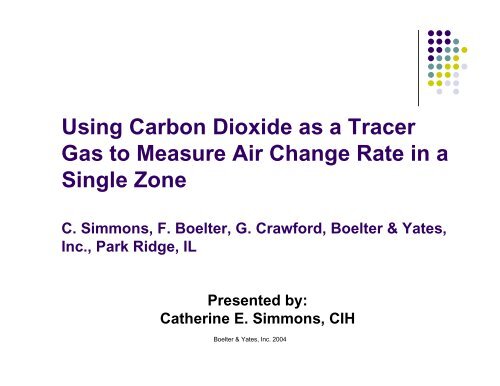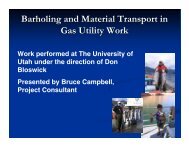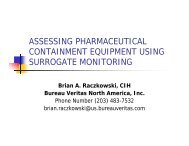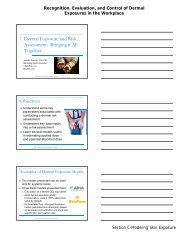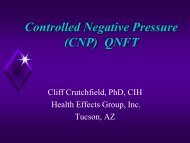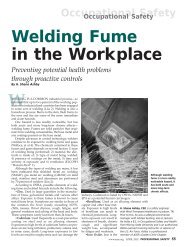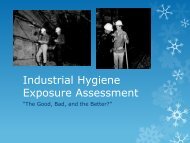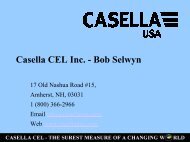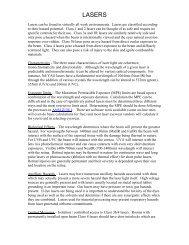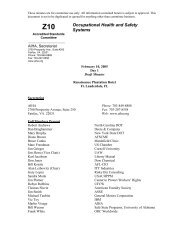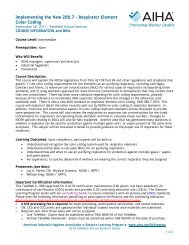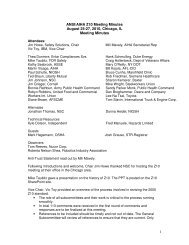Using Carbon Dioxide as a Tracer Gas to Measure Air Change Rate ...
Using Carbon Dioxide as a Tracer Gas to Measure Air Change Rate ...
Using Carbon Dioxide as a Tracer Gas to Measure Air Change Rate ...
You also want an ePaper? Increase the reach of your titles
YUMPU automatically turns print PDFs into web optimized ePapers that Google loves.
<strong>Using</strong> <strong>Carbon</strong> <strong>Dioxide</strong> <strong>as</strong> a <strong>Tracer</strong><br />
G<strong>as</strong> <strong>to</strong> Me<strong>as</strong>ure <strong>Air</strong> <strong>Change</strong> <strong>Rate</strong> in a<br />
Single Zone<br />
C. Simmons, F. Boelter, G. Crawford, Boelter & Yates,<br />
Inc., Park Ridge, IL<br />
Presented by:<br />
Catherine E. Simmons, CIH<br />
Boelter & Yates, Inc. 2004
Situation<br />
Ventilation information w<strong>as</strong> needed <strong>to</strong><br />
perform a retrospective exposure<br />
<strong>as</strong>sessment.<br />
Procedure w<strong>as</strong> needed <strong>to</strong> determine the<br />
ventilation rate in air changes per hour<br />
(ACH) for representative boiler rooms and<br />
an isolation test chamber.<br />
Boelter & Yates, Inc. 2004
Boiler Room Ventilation<br />
Research<br />
Published Information on Boiler Room <strong>Air</strong><br />
<strong>Change</strong> <strong>Rate</strong>s<br />
ASHRAE, BOCA and NFPA reviewed for<br />
ventilation requirements in ACH<br />
Ventilation Models <strong>Using</strong> <strong>Tracer</strong> G<strong>as</strong><br />
Published Ventilation Models using <strong>Tracer</strong> G<strong>as</strong><br />
Standard Test Method for Determining <strong>Air</strong><br />
<strong>Change</strong> in a Single Zone by Means of a <strong>Tracer</strong><br />
G<strong>as</strong> Dilution – ASTM E 741 – 00<br />
Boelter & Yates, Inc. 2004
Problem<br />
Existing methods allow for the use of a variety of tracer<br />
g<strong>as</strong>es <strong>to</strong> be used.<br />
Each h<strong>as</strong> advantages and disadvantages.<br />
Selected method<br />
highly portable<br />
e<strong>as</strong>ily me<strong>as</strong>ured<br />
non-<strong>to</strong>xic or very low <strong>to</strong>xicity<br />
inexpensive<br />
<strong>Tracer</strong> g<strong>as</strong> acceptable <strong>to</strong> school district personnel.<br />
Boelter & Yates, Inc. 2004
Research<br />
Standard Test Method for Determining <strong>Air</strong> <strong>Change</strong> in a<br />
Single Zone by Means of a <strong>Tracer</strong> G<strong>as</strong> Dilution – ASTM E<br />
741 – 00<br />
<strong>Tracer</strong> g<strong>as</strong>es (examples)<br />
CO 2 – PEL 5000 ppm<br />
SF 6 – PEL 1000 ppm<br />
CO – PEL 50 ppm<br />
Selection of test method<br />
Concentration Decay<br />
Constant Injection<br />
Constant Concentration<br />
Boelter & Yates, Inc. 2004
Resolution<br />
Selection of tracer g<strong>as</strong><br />
<strong>Carbon</strong> dioxide<br />
Relatively high PEL<br />
Inexpensive<br />
E<strong>as</strong>y <strong>to</strong> obtain and me<strong>as</strong>ure<br />
Acceptable <strong>to</strong> School personnel<br />
Selection of method<br />
Concentration Decay Test Method<br />
Me<strong>as</strong>ures the decay rate of carbon dioxide over<br />
time <strong>to</strong> calculate the air exchange rate.<br />
Regression Analysis<br />
InC(t) = -At + C(0)<br />
<br />
Boelter & Yates, Inc. 2004
Sample Time<br />
<strong>Air</strong> <strong>Change</strong> <strong>Rate</strong> (1/hr)<br />
0.25<br />
0.5<br />
1<br />
2<br />
4<br />
Boelter & Yates, Inc. 2004<br />
Minimum Duration (hour)<br />
4<br />
2<br />
1<br />
.5<br />
.25<br />
Minimum sample duration b<strong>as</strong>ed on 10% uncertainty at the 95%<br />
confidence level in the detection of air change rate, a tracer g<strong>as</strong><br />
concentration me<strong>as</strong>urement precision error of 5% of reading and<br />
various air change rate. <strong>Using</strong> the regression method reduces the<br />
minimum test duration due <strong>to</strong> more than 2 data points.
Boiler Room Ventilation<br />
Testing <strong>Using</strong> <strong>Tracer</strong> G<strong>as</strong><br />
Representative Boiler Rooms<br />
Elementary School - IN<br />
Elementary School - IL<br />
Middle School - IL<br />
Boelter & Yates, Inc. 2004
G<strong>as</strong> Injection and Distribution<br />
Boelter & Yates, Inc. 2004
Direct Reading Equipment<br />
TSI Q-Trak<br />
Log Data<br />
Boelter & Yates, Inc. 2004
School<br />
Indiana<br />
• 5500 ft 3 Boiler Room<br />
• Volume of g<strong>as</strong> needed<br />
• Calculated b<strong>as</strong>ed on room<br />
size and target<br />
concentration of 4000 ppm<br />
V tracer = C target X V zone<br />
• 2 boilers<br />
– Input BTU/hr. - 117,000<br />
– Input BTU/hr. – 156,000<br />
• Both boilers operating<br />
during the testing<br />
• No mechanical ventilation<br />
Boelter & Yates, Inc. 2004
<strong>Carbon</strong> <strong>Dioxide</strong><br />
Concentration in Parts Per<br />
Million (PPM)<br />
4500<br />
4000<br />
3500<br />
3000<br />
2500<br />
2000<br />
1500<br />
1000<br />
500<br />
0<br />
Average CO2 Concentration vs Time<br />
Indiana Boiler Room - 2 Boilers Operating<br />
March 26, 2003<br />
1 7 13 19 25 31 37 43 49 55 61 67 73<br />
Time in Minutes<br />
Trial 1 – 5.2 ACH Trial 2 – 5.3 ACH<br />
Average 5.2 ACH<br />
Boelter & Yates, Inc. 2004<br />
Trial 1 - Average<br />
CO2 Concentration<br />
(PPM) 5.2 <strong>Air</strong><br />
<strong>Change</strong>s Per Hour<br />
Trial 2 - Average<br />
CO2 Concentration<br />
(PPM) 5.3 <strong>Air</strong><br />
<strong>Change</strong>s Per Hour
Elementary School<br />
Illinois<br />
• Me<strong>as</strong>ured Volume –<br />
24,322 ft3 .<br />
• 2 Boilers<br />
• Ventilation tracer<br />
g<strong>as</strong> testing<br />
conducted with<br />
boilers on and off.<br />
Boelter & Yates, Inc. 2004
4000<br />
3000<br />
2000<br />
1000<br />
0<br />
Ventilation <strong>Rate</strong> - Boilers Off<br />
1.8 <strong>Air</strong> <strong>Change</strong>s Per Hour<br />
March 27, 2003<br />
0 18.75 37.5 56.25<br />
Time in Minutes<br />
Trial 1<br />
Boilers Off - 1.8 ACH<br />
Elementary School<br />
<strong>Carbon</strong> <strong>Dioxide</strong><br />
Concentration<br />
(ppm)<br />
<strong>Carbon</strong> <strong>Dioxide</strong><br />
Concentration<br />
(ppm)<br />
5000<br />
4000<br />
3000<br />
2000<br />
1000<br />
0<br />
Boelter & Yates, Inc. 2004<br />
Average CO2 Concentration vs Time<br />
March 27, 2003<br />
0<br />
2.25<br />
4.5<br />
6.75<br />
9<br />
11.3<br />
13.5<br />
15.8<br />
18<br />
20.3<br />
22.5<br />
24.8<br />
27<br />
29.3<br />
31.5<br />
Time in Minutes<br />
Boilers On<br />
Trial 2 – 3.5 ACH<br />
Trial 3 – 3.9 ACH<br />
Average 3.7 ACH<br />
Trial 2 - Average <strong>Carbon</strong><br />
<strong>Dioxide</strong> Concentrations<br />
with 2 Boilers Operating<br />
Trial 3 - Average <strong>Carbon</strong><br />
<strong>Dioxide</strong> Concentrations<br />
with 2 Boilers Operating
Middle School<br />
Illinois<br />
16,372 ft 3<br />
Boiler<br />
Room<br />
2 Identical<br />
Boilers<br />
Boelter & Yates, Inc. 2004
5000<br />
4000<br />
3000<br />
2000<br />
1000<br />
0<br />
Average <strong>Carbon</strong> <strong>Dioxide</strong> Concentration (ppm) vs<br />
Time<br />
Middle School<br />
March 21, 2003<br />
0 25 50<br />
Time in Minutes<br />
75<br />
Boilers Off<br />
1.2 ACH<br />
Middle School<br />
<strong>Carbon</strong> <strong>Dioxide</strong><br />
Concentration (ppm)<br />
<strong>Carbon</strong> <strong>Dioxide</strong><br />
Concentration (PPM)<br />
Boelter & Yates, Inc. 2004<br />
Average CO2 Concentration vs Time<br />
Boiler Room - 2 Boilers<br />
March 31, 2003<br />
5000<br />
4000<br />
3000<br />
2000<br />
1000<br />
0<br />
1 112131415161718191<br />
Time in Minutes<br />
Boilers On<br />
Trial 2 - 4.4 ACH<br />
Trial 3 - 5.3 ACH<br />
Average – 4.9 ACH<br />
Boilers On (1 boiler on part<br />
time): Trial 2 - Average CO2<br />
Concentration 4.4 <strong>Air</strong><br />
<strong>Change</strong>s Per Hour,<br />
GlenCrest School March 31,<br />
2003<br />
Boilers On: Trial 3 - Average<br />
CO2 Concentration 5.3 <strong>Air</strong><br />
<strong>Change</strong>s Per Hour,<br />
GlenCrest School March 31,<br />
2003
Me<strong>as</strong>ured Range of Boiler Room<br />
Ventilation<br />
Summary<br />
Boilers Off<br />
Range: 1.2 <strong>to</strong> 1.8 ACH<br />
Boilers On<br />
Range: 3.7 <strong>to</strong> 4.9 ACH<br />
Boelter & Yates, Inc. 2004
Isolation Test Chamber<br />
• Approximately 20’ x 20’ x 9’<br />
(3600 ft3 )<br />
• Wood Frame<br />
• Polyethylene sheeting on<br />
walls and floors<br />
Boelter & Yates, Inc. 2004<br />
• 2 viewing windows<br />
• Entrance airlock<br />
• Decontamination Shower (if<br />
needed)<br />
• HEPA filtered exhaust<br />
machines for ventilation
HEPA Filtered Exhaust Machines<br />
for Chamber Ventilation System<br />
Note: <strong>Using</strong> various configurations, both machines operated<br />
<strong>as</strong> exhaust (tubing w<strong>as</strong> attached <strong>to</strong> machines <strong>to</strong> exhaust<br />
outside the building).<br />
Boelter & Yates, Inc. 2004
Installation and Me<strong>as</strong>urement of<br />
Ventilation System<br />
Various configurations <strong>to</strong> achieve<br />
approximately 1, 3, 5 and 10 ACH<br />
<strong>Carbon</strong> dioxide tracer g<strong>as</strong> used <strong>to</strong><br />
me<strong>as</strong>ure ventilation rate.<br />
Each rate tested twice <strong>to</strong> <strong>as</strong>sure<br />
repeatability.<br />
Final ventilation rates were: 1.2, 2.9, 5.7,<br />
10.7 ACH.<br />
Boelter & Yates, Inc. 2004
<strong>Carbon</strong> <strong>Dioxide</strong><br />
Concentration (ppm)<br />
6000<br />
5000<br />
4000<br />
3000<br />
2000<br />
1000<br />
<strong>Carbon</strong> <strong>Dioxide</strong> Concentration (ppm) vs Time<br />
B & Y Test Chamber<br />
5.7 <strong>Air</strong> <strong>Change</strong>s Per Hour<br />
April 29, 2003<br />
0<br />
16:28<br />
16:30<br />
16:32<br />
16:34<br />
16:36<br />
16:38<br />
16:40<br />
Time<br />
Trial 1 – 5.8 ACH Trial 2 – 5.8 ACH<br />
Trial 1 – 5.8 ACH Trial 2 – 5.5 ACH<br />
16:42<br />
16:44<br />
Boelter & Yates, Inc. 2004<br />
Average 5.7<br />
16:46<br />
16:48<br />
16:50<br />
Trial 1 - high<br />
Trial 1 - low<br />
Trial 2 - high<br />
Trial 2 - low
Conclusions<br />
Ventilation rates for representative boiler<br />
rooms were between 1 and 5 ACH.<br />
<strong>Using</strong> carbon dioxide <strong>as</strong> a tracer g<strong>as</strong> and<br />
following ASTM E 741 – 00, Standard Test<br />
Method for Determining <strong>Air</strong> <strong>Change</strong> in a<br />
Single Zone by Means of a <strong>Tracer</strong> G<strong>as</strong><br />
Dilution met the objectives and goals of the<br />
project.<br />
Boelter & Yates, Inc. 2004
Benefits<br />
<strong>Carbon</strong> <strong>Dioxide</strong> <strong>as</strong> a tracer g<strong>as</strong><br />
Inexpensive, reliable procedure for IH’s <strong>to</strong> determine<br />
ventilation rates.<br />
Me<strong>as</strong>uring Equipment is readily available<br />
The method provides an additional <strong>to</strong>ol for<br />
industrial hygienists <strong>to</strong> better characterize<br />
workplace conditions during the initial stages of<br />
an exposure <strong>as</strong>sessment.<br />
Ventilation information is critical <strong>to</strong> the ability <strong>to</strong><br />
perform and validate mathematical modeling for<br />
exposure estimation.<br />
Boelter & Yates, Inc. 2004
C(t)<br />
Well Mixed Room Model - Constant<br />
Contaminant Emission <strong>Rate</strong><br />
G + C ⋅ Q ⎡ ⎛ Q + k ⋅ V ⎞⎤<br />
⎛ Q + k ⋅ V ⎞<br />
IN ⎢ ⎜<br />
L ⎟⎥<br />
+ ⎜<br />
L<br />
= 1−<br />
exp − t C exp − t ⎟<br />
Q + k ⋅ V ⎢ ⎜<br />
⎟⎥<br />
⎜<br />
⎟<br />
⎣ ⎝<br />
V<br />
0<br />
⎠⎦<br />
⎝<br />
V<br />
L<br />
⎠<br />
Input Variables<br />
C IN<br />
V m 3<br />
K L<br />
C 0<br />
mg/m 3<br />
G mg/min<br />
Q m 3/min<br />
per min<br />
mg/m 3<br />
Boelter & Yates, Inc. 2004<br />
Concentration in incoming air<br />
Generation <strong>Rate</strong><br />
Exhaust air flow<br />
Volume of Room<br />
Loss Pathway (sinks)<br />
Initial concentration
0.7<br />
0.6<br />
0.5<br />
0.4<br />
0.3<br />
0.2<br />
0.1<br />
0<br />
0<br />
3<br />
6<br />
9<br />
Predicted Concentration at 0.01, 0.1, 1, 3, 4, 5 and 10<br />
<strong>Air</strong> <strong>Change</strong>s Per Hour<br />
12<br />
Effect of Ventilation <strong>Rate</strong> on<br />
Concentration of Contaminant<br />
15<br />
18<br />
21<br />
24<br />
27<br />
30<br />
33<br />
36<br />
Boelter & Yates, Inc. 2004<br />
39<br />
42<br />
45<br />
0.01<br />
ACH<br />
0.1<br />
ACH<br />
1 ACH<br />
3 ACH<br />
4 ACH<br />
5 ACH<br />
10<br />
ACH
Thank you!<br />
Questions?<br />
Speaker Contact Information:<br />
Catherine E. Simmons, CIH<br />
Boelter & Yates, Inc.<br />
Park Ridge, IL<br />
csimmons@boelter-yates.com<br />
Boelter & Yates, Inc. 2004


